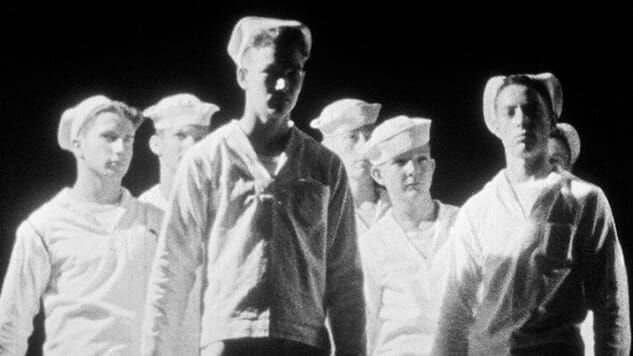Looking Back with Anger: Mythologies of White Masculinity in Fireworks and Scorpio Rising

Kenneth Anger’s ghost haunts much of modern pop culture. Incongruous and sex-filled music videos, calendars with sweaty working class guys, a majority of queer cinema: a lover of the occult, of leather, of the codes of masculinity, writer/filmmaker/actor Anger’s work used a dreamscape to deconstruct masculinity outside of its social confines. He rubbed shoulders with Jean Cocteau and occultist Aleister Crowley, he made films that got him arrested on obscenity charges and he penned one of the most infamous collection of gossipy stories Hollywood ever saw.
Film historian Karina Longworth, the host and creator of You Must Remember This, has dedicated the latest season of her podcast to fact-checking Anger’s book, Hollywood Babylon. Originally written as stories and essays for Cahiers du Cinéma, then published in Paris in 1959 to minimal fanfare, then published in the United States in 1965 during the height of the Hollywood New Wave, the book details and contrives versions of scandals and salacious Hollywood tales that indicted (or at least smudged) the names of people like Charlie Chaplin, D.W. Griffith, Fatty Arbuckle, Marilyn Monroe and Judy Garland. Longworth calls the book a “Hollywood party game of telephone” with its inconsistencies, exaggerations and outright misinformation. It flourished, cementing Anger’s legacy as meta-fantasist deviant in history. Longworth has admirably committed to investigating what facts can be found about 19 of the stories featured in the book.
Anger’s role as an avant-garde filmmaker, though, is as intertwined with his work as his role as a libelous storyteller. Regardless of whether the accounts in Hollywood Babylon were true, Anger was fascinated with how Hollywood branded itself, how wealth, sex, drugs, etc. could run amok within a group of people with power, and what that represented in the rest of us. Without condoning his tales in Hollywood Babylon, we can still consider how easily certain people—or character versions of those people—fit easily within the archetypes that he would unpack in his films. Men, the power they had and how they used it in the context of desire was a favorite subject. Whether talking about Griffith, director of The Birth of a Nation and Intolerance, and his pedophilic predilections or Fatty Arbuckle’s rape scandal, Anger demonstrates a clear fixation on the relationship between male power and sex. He, for better and worse, mythologizes the kind of influence that these men have, mythologizes what sexuality means with respect to the gendered biases of both the Hollywood industry and the audiences dazzled by its mythmaking. Hollywood Babylon, its own kind of fan fiction, could look back and loosely use the fevered stories, some of which came from fan ’zines themselves, to morph, like a fun house mirror, audience and industry into the unrecognizable.
His earliest known surviving film is Fireworks, made in 1947 when his parents were away for a weekend. The sculpted men of the short are both recognizable and yet hyperbole, exaggeration—fantasy. Their actions and gestures (with sex, with violence, within communal circles) are captured in the abstract, Anger attempting to understand their phantasmagoric significance in engendering queer desire. The hands and bare chests, the backs and the sailor outfits: These code archetypes with intention, as if longing could be carved into their bodies. Anger astonishingly can present queer desire both as post-World War II reality (violence, gang rape, homophobia, baiting) and as euphoric unreality (sadomasochism, bukkake). It’s masculinity as dream and nightmare.
-

-

-

-

-

-

-

-

-

-

-

-

-

-

-

-

-

-

-

-

-

-

-

-

-

-

-

-

-

-

-

-

-

-

-

-

-

-

-

-








































